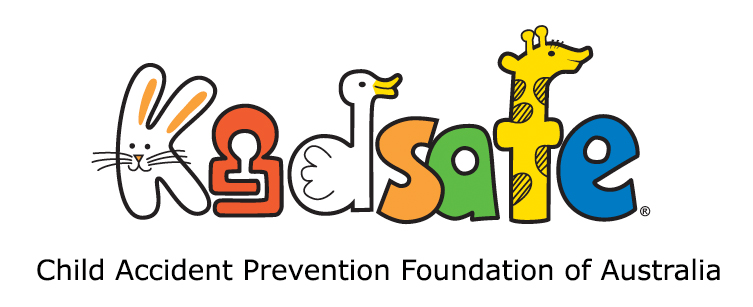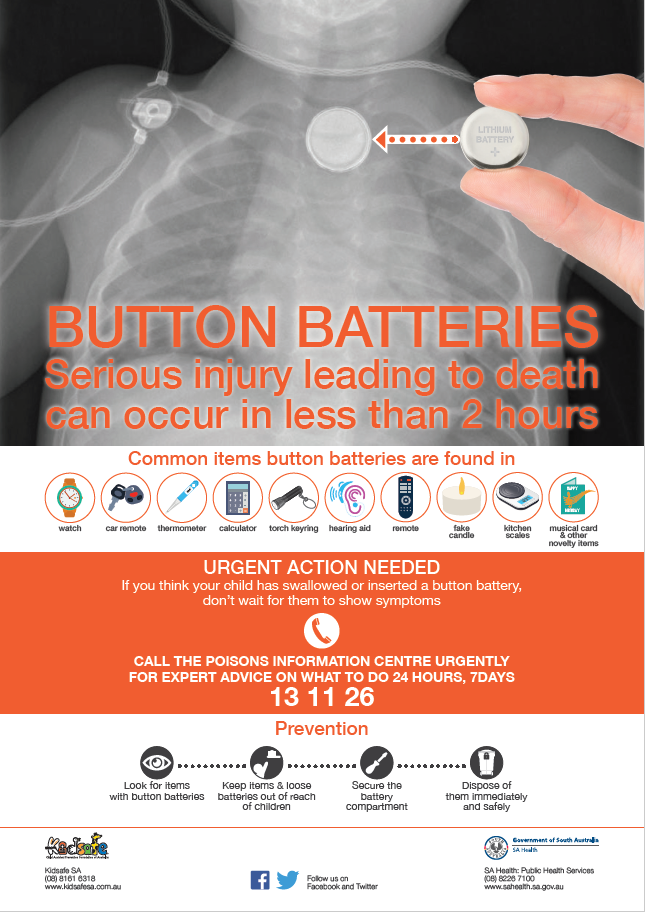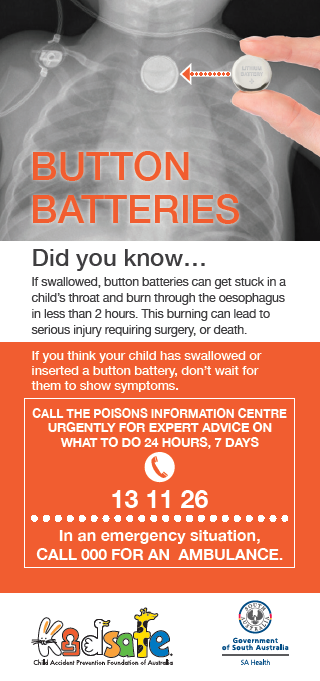They may be small, but if a child swallows a button battery; even a used one, it can burn through soft tissue in just two hours causing horrendous internal injuries and even cause death.
Car remotes, calculators, thermometers, musical greeting cards, flashing novelty goods and kitchen scales – button batteries are everywhere in a variety of objects in and around the home.
In Australia an estimated 20 children a week present to a hospital emergency department suspected of having ingested or inserted a button battery and children aged 0-5 years are particularly vulnerable.
Roughly one child a month sustains a severe injury requiring a procedure to remove the battery or repair damage.
Learn more about the risks of button batteries in the home, how to reduce these risks and what to do if you suspect your child has swallowed one.
What are the risks of button batteries to young children?
A new button battery or a flat lithium button battery when it mixes with saliva creates an electrical current that causes a chemical reaction and burns through soft tissue in as little as two hours but may take days. Depending on where the button battery becomes lodged when ingested, it can burn the oesophagus, stomach, lungs, larynx or bowel, causing catastrophic injuries and even death.
Even after a coin-sized button battery is removed, the burning can continue and repairing the damage may require multiple surgeries.
Who is most at risk from button batteries?
Young children (0-5years) are particularly vulnerable to choking on or ingesting a button battery because of the relative small size of their esophagus and because they are curious and are most likely to put objects in their mouths in their ears and up their noses.
Button batteries are small, can give a slight buzz on the tongue and look appealing to small children – like a lollie – so they are tempting to a child.
Read more about risks of choking and suffocation here
How to avoid the risk of button batteries
Many of the products that contain button batteries are not classified as toys and therefore don’t have to meet the same safety standards that toys do. Follow these simple steps to be button battery aware:
Identify all items in your home that contain button batteries. Examples include children’s toys, remote controls, watches, cameras, bathroom scales and flashing novelties.
Secure the battery compartment. Make sure the battery compartment can only be opened with a screwdriver or by applying two distinct and separate movements. Use gaffer tape to secure remote controls.
Elevate button batteries and items containing button batteries out of reach of children in a locked cupboard or container.
Eliminate button battery items from your home by buying alternate products that use regular batteries or a different power source. Safely dispose of any items you no longer need. Dispose of used button batteries immediately by wrapping in sticky tape and taking to a recycling centre.
What are the symptoms of swallowing a button battery?
A range of symptoms are associated with ingestion of a button battery:
• gagging or choking
• drooling
• chest pain (this may present as grunting)
• coughing or noisy breathing
• unexplained vomiting or food refusal
• bleeding from the gut — black or red vomit or bowel motions
• nose bleeds — sometimes this can be blood vomited through the nose
• grunting
• unexplained fever
• abdominal pain
• general discomfort
• spitting blood or blood-stained saliva
• or no symptoms at all
These symptoms are often associated with other conditions so it is important to consider them in light of the likelihood that your child has had access to button batteries or equipment that may contain button batteries.
If you suspect your child has ingested a button battery
- If your child is having any difficulty breathing, call 000 immediately.
- Contact the Poisons Information Centre on 13 11 26 and you will be directed to the nearest hospital or emergency service that can manage the injury.
- Prompt action is critical. Do not wait for symptoms to develop.
- Do not let the child eat or drink until an X-ray is taken.
- Do not induce vomiting.
SAFE DISPOSAL OF BATTERIES
Fires can occur anywhere that batteries are stored together and, even a single button battery can ignite!
Wrap battery terminals with sticky tape before disposing or, better still, taking to a recycling centre.
Wrapping both sides of a button battery will not only assist with the prevention of fires, but children and dogs will be less likely to swallow them.



